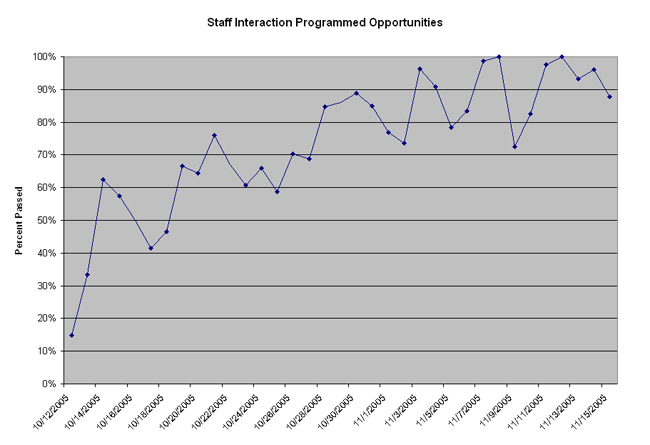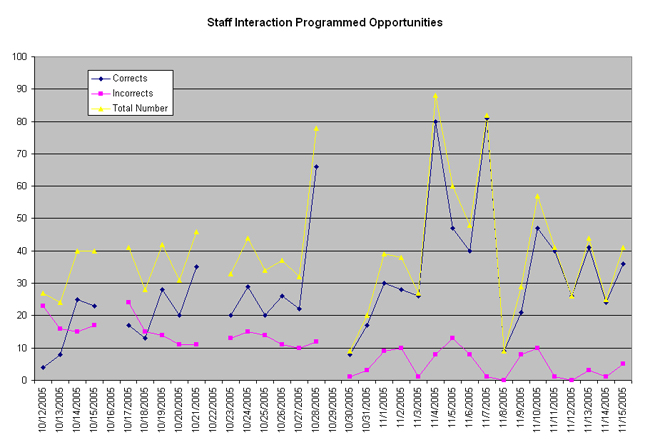
|
Use of Skin-Shock at the Judge Rotenberg Educational Center (JRC) |
THE EFFECTIVENESS OF PROGRAMMED OPPORTUNITIES TO
DECELERATE THE FREQUENCY
OF INAPPROPRIATE STAFF INTERACTIONS IN THE WORKPLACE
Thelmisha Vincent, Kelly Ilsley, Kamah Thomas, Ed Langford, and Matthew Israel
Judge Rotenberg Educational Center
Canton, MA USA
The Judge Rotenberg Educational Center (JRC) operates day and residential programs for children and adults with behavior problems, including conduct disorders, emotional problems, brain injury or psychosis, autism and developmental disabilities. The basic approach taken in all of JRC's programs is the use of behavioral psychology and its various technological applications, such as behavioral education, programmed instruction, precision teaching, behavior modification, behavior therapy and behavioral counseling. From JRC's inception, its basic philosophy has always included the following principles: a willingness to accept students with the most difficult behavioral problems and a refusal to reject or expel any student because of the difficulty of his or her presenting behaviors; the use of a highly structured, consistent application of behavioral psychology to both the education and treatment of its students; a minimization of the use of psychotropic medication; and the use of the most effective behavioral education and treatment procedures available.
Summary
Programmed opportunities, used as a method of shaping staff members’ behavior, were effective in decelerating the frequency in which staff engaged in inappropriate social conversations with each other in the work place.
Introduction
Cooper, Heron, and Heward (1987) emphasize the utility of Opportunities Programmed into the daily routine as an effective tool in teaching new skills. At JRC, the term “programmed opportunities” is used to refer to three different types of situations: academic programmed opportunities; social programmed opportunities; and treatment programmed opportunities…In each case, a stimulus is deliberately presented (hence, “programmed”); a response is then sought from the recipient (student or staff member); training and prompting is provided to the recipient to help him/her respond correctly; and the student or staff member is then consequated appropriately. (Adapted from JRC Procedures on Programmed Opportunities, revised 2/23/06)
Methods
Programmed opportunities were implemented for staff members in order to address administrative concerns about inappropriate staff interactions observed by students. Frequent inappropriate interactions between staff members jeopardize the integrity of students’ treatment programs, and pose a potential simultaneous threat to staff members’ and students’ confidentiality and safety. Our Quality Control Department set a minimum goal of conducting 25 randomly assigned programmed opportunities per day throughout our population of 900 staff members over a 5 week data collection period. Staff members received immediate verbal feedback, and cumulative written evaluations documented staff members’ performance during these programmed opportunities. A progressive disciplinary system is in place to consequate inappropriate behaviors, and supplemental training tools may also be implemented to further educate and correct staff members’ performance. Data is graphically presented to demonstrate the apparent effectiveness of our interventions to decrease inappropriate staff interactions, while simultaneously increasing appropriate interactions as depicted in Figure 1.
Figure 1

Results
Initial Pass/Fail Rate: 15% Pass 85% Fail ( Figure 2)
End Pass/Fail Rate: 88% Pass 12% Fail ( Figure 2)
5 week period: 1,260 opportunities were randomly conducted throughout population of 900 staff members across all shifts.
Figure 2

Discussion
Staff members witnessing the programmed opportunities, participating in them, and receiving performance credits and/or performance improvement opportunity demerits led to a rapid deceleration of inappropriate responses to the programmed opportunities.
References
Cooper, Heron, & Heward (1987). Applied Behavior Analysis. Upper Saddle River, NJ: Merrill/Prentice Hall.